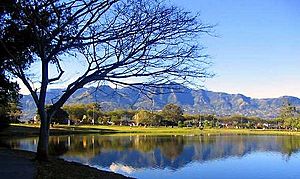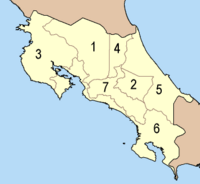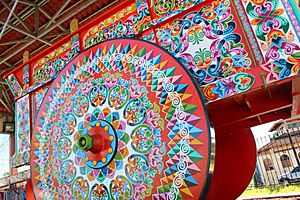Costa Rica facts for kids
Quick facts for kids
Republic of Costa Rica
República de Costa Rica (Spanish)
|
|
|---|---|
|
|
|
 |
|
| Capital and largest city
|
San José 9°56′N 84°5′W / 9.933°N 84.083°W |
| Official languages | Spanish |
| Recognized regional languages |
|
| Ethnic groups
(2021)
|
|
| Religion
(2021)
|
|
| Demonym(s) |
|
| Government | Unitary presidential republic |
| Rodrigo Chaves | |
| Stephan Brunner | |
| Mary Munive | |
| Legislature | Legislative Assembly |
| Independence from | |
|
• from Spain
|
15 September 1821 |
|
• from First Mexican Empire
|
1 July 1823 |
|
• from the Federal
Republic of Central America |
14 November 1838 |
|
• Current constitution
|
7 November 1949 |
|
• Recognized by Spain
|
10 May 1850 |
| Area | |
|
• Total
|
51,179.92 km2 (19,760.68 sq mi) (126th) |
|
• Water (%)
|
1.05 (as of 2015) |
| Population | |
|
• 2022 census
|
5,044,197 |
|
• Density
|
220/sq mi (84.9/km2) (107th) |
| GDP (PPP) | 2023 estimate |
|
• Total
|
|
|
• Per capita
|
|
| GDP (nominal) | 2023 estimate |
|
• Total
|
|
|
• Per capita
|
|
| Gini (2022) | ▼ 47.2 high |
| HDI (2022) | very high · 64th |
| Currency | Costa Rican colón (CRC) |
| Time zone | UTC−6 (CST) |
| Driving side | right |
| Calling code | +506 |
| ISO 3166 code | CR |
| Internet TLD | .cr .co.cr |
Costa Rica (meaning "Rich Coast") is a country in Central America. It is officially called the Republic of Costa Rica (Spanish: República de Costa Rica). The country is bordered by Nicaragua to the north and Panama to the southeast. It also has coasts on the Caribbean Sea and the Pacific Ocean.
About five million people live in Costa Rica. The capital and largest city is San José. Around two million people live in the area around San José.
Costa Rica is a stable republic with a president as its leader. It has a long history of democracy. The country spends a lot of its money on education. Its economy used to rely on farming. Now, it also includes finance, services for foreign companies, medicine, and ecotourism. Many foreign companies have businesses in Costa Rica.
Before the 1500s, native people lived in Costa Rica. Then, it became part of the Spanish Empire. Costa Rica became independent from Spain in 1821. After a short civil war in 1948, Costa Rica made a big decision. It got rid of its army in 1949. This makes it one of the few countries without a standing army.
Costa Rica is known for its high Human Development Index (HDI). This means people there have a good quality of life. It ranks high in Latin America for human development. It also does well in areas like democracy, press freedom, and happiness. Costa Rica is often called one of the happiest countries in the world.
Contents
History of Costa Rica
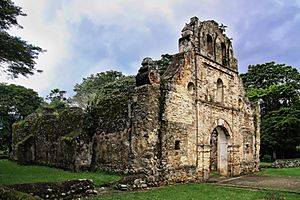
Ancient Times
The native people of Costa Rica lived in an area where different cultures met. These were the Mesoamerican and Andean cultures. Many of these groups spoke Chibcha languages.
The culture of these native people did not have a huge impact on modern Costa Rica. Most of them became part of the Spanish colony. Today, there are still small native groups. The largest are the Bribri and Boruca tribes in the south.
Spanish Rule
Christopher Columbus arrived on the eastern coast of Costa Rica in 1502. He saw that the native people had a lot of gold jewelry.
During the time of Spanish rule, Costa Rica was the southernmost part of the Captaincy General of Guatemala. But it mostly governed itself. Costa Rica was far from the capital in Guatemala. Also, it was not allowed to trade with other areas. There was also not much gold or silver. This made Costa Rica a poor and less populated part of the Spanish Empire. A Spanish governor even called it "the poorest and most miserable Spanish colony" in 1719.
Because there were not many native people to force into labor, Spanish settlers had to work their own land. There were no big haciendas (large farms). So, Spain did not pay much attention to Costa Rica. This allowed the region to develop on its own.
Costa Rica became a "rural democracy." This meant most people owned their own land. Spanish settlers soon moved to the hills. There, they found rich volcanic soil and a better climate.
Becoming Independent
Costa Rica did not fight a war to become independent from Spain. On September 15, 1821, Central America declared its independence. This happened after Spain's defeat in the Mexican War of Independence. Costa Rica still celebrates this date as its Independence Day.
After independence, Costa Rica joined the First Mexican Empire. When that empire fell in 1823, Costa Rica became part of the Federal Republic of Central America. This republic lasted from 1823 to 1839. It had weak control over its parts, especially poor and distant Costa Rica.
In 1824, the capital of Costa Rica moved to San José. This caused a small fight with the old capital, Cartago.
While other parts of the Federal Republic of Central America had civil wars, Costa Rica was mostly peaceful.
In 1838, Costa Rica officially became an independent country. The people there did not feel very loyal to the federal government in Guatemala. Even today, Costa Rica prefers not to be too closely linked politically with other Central American countries.
Economic Growth
Coffee was first grown in Costa Rica in the early 1800s. It was first sent to Europe in 1843. Coffee quickly became Costa Rica's main export. It remained the biggest export until the 1900s.
Most coffee was carried by oxcart to the Pacific port of Puntarenas. Since Europe was the main market, a route to the Atlantic Ocean was needed. In the 1870s, the government asked U.S. businessman Minor C. Keith to build a railroad. This railroad would go to the Caribbean port of Limón. The railroad was very difficult to build. There were problems with disease and money. But it was finished in 1890.
Many Afro-Costa Ricans are descendants of Jamaican immigrants. These immigrants came to work on the railway. Workers from the United States, Italy, and China also helped build the railroad.
In return for building the railroad, Keith received large areas of land. He also got a lease for the train route. He used this land to grow bananas and export them to the United States. Because of this, bananas became the largest export. The United Fruit Company became very important to Costa Rica's economy.
20th Century Changes
Costa Rica has had more peace and political stability than many other Latin American countries.
However, from 1917 to 1919, General Federico Tinoco Granados ruled as a military dictator. He was later overthrown. His unpopular government led to the Costa Rican military becoming smaller and less powerful.
In 1948, José Figueres Ferrer led an uprising. This was against the former president Rafael Ángel Calderón Guardia. The Costa Rican Civil War lasted 44 days and was the bloodiest event in Costa Rica in the 20th century. More than 2,000 people died.
The winning side formed a government that got rid of the military. They also created a new constitution. After these changes, the government gave up its power on November 8, 1949. A new democratic government took over. Figueres became a national hero. He won the country's first democratic election under the new constitution in 1953. Since then, Costa Rica has had many peaceful and fair presidential elections.
Geography and Climate
Costa Rica is located on the Central American isthmus. This is a narrow strip of land connecting two larger landmasses. It is between 8 and 12 degrees north of the Equator. The country has coasts on the Caribbean Sea to the east and the Pacific Ocean to the west. It has a total of 1,290 kilometres (800 mi) of coastline.
Costa Rica shares borders with Nicaragua to the north and Panama to the southeast. The country covers 51,100 square kilometres (19,700 sq mi) of land. It also has 589 square kilometres (227 sq mi) of territorial waters.
The highest point in Costa Rica is Cerro Chirripó, which is 3,819 metres (12,530 ft) tall. The largest lake is Lake Arenal.
Weather in Costa Rica
Costa Rica is close to the Equator. This means it has a tropical climate all year round. The country has many different microclimates. These depend on the elevation, rainfall, and geography of each area.
Costa Rica's seasons are based on how much rain falls. It does not have the four seasons like some other countries. The year has two main seasons:
- The dry season (called summer) lasts from December to April.
- The rainy season (called winter) lasts from May to November. During this time, it rains often in some regions.
The Caribbean coast gets the most rain. It receives over 5,000 mm (196.9 in) of rain each year. It is also very humid there. The average yearly temperature on the coast is about 27 °C (81 °F). In the main populated areas, it is around 20 °C (68 °F). On the highest mountains, temperatures can drop below 10 °C (50 °F).
| Climate data for Costa Rica | |||||||||||||
|---|---|---|---|---|---|---|---|---|---|---|---|---|---|
| Month | Jan | Feb | Mar | Apr | May | Jun | Jul | Aug | Sep | Oct | Nov | Dec | Year |
| Mean daily maximum °C (°F) | 27 (81) |
27 (81) |
28 (82) |
28 (82) |
27 (81) |
27 (81) |
27 (81) |
27 (81) |
26 (79) |
26 (79) |
26 (79) |
26 (79) |
27 (81) |
| Mean daily minimum °C (°F) | 17 (63) |
18 (64) |
18 (64) |
18 (64) |
18 (64) |
18 (64) |
18 (64) |
18 (64) |
17 (63) |
18 (64) |
18 (64) |
18 (64) |
18 (64) |
| Average precipitation mm (inches) | 6.3 (0.25) |
10.2 (0.40) |
13.8 (0.54) |
79.9 (3.15) |
267.6 (10.54) |
280.1 (11.03) |
181.5 (7.15) |
276.9 (10.90) |
355.1 (13.98) |
330.6 (13.02) |
135.5 (5.33) |
33.5 (1.32) |
1,971 (77.61) |
| Percent possible sunshine | 40 | 37 | 39 | 33 | 25 | 20 | 21 | 22 | 20 | 22 | 25 | 34 | 28 |
Many national parks can be found in Costa Rica, like Manuel Antonio National Park.
Amazing Plants and Animals
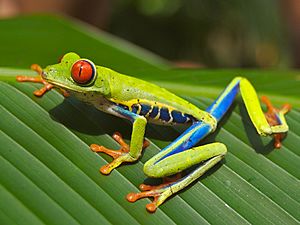
Costa Rica is home to a huge variety of plants and animals. It has only about 0.25% of the world's land. But it holds 5% of the world's biodiversity. Almost 25% of Costa Rica's land is protected in national parks and other areas. This is the highest percentage of protected land in the world.
Costa Rica has done a great job reducing deforestation. It used to have one of the worst deforestation rates from 1973 to 1989. But by 2005, it was almost zero.
The Corcovado National Park is famous among ecologists for its rich biodiversity. Visitors can see many different animals there. These include big cats and tapirs. Corcovado is the only park in Costa Rica where all four types of Costa Rican monkeys live. These are the white-headed capuchin, the mantled howler, the endangered Geoffroy's spider monkey, and the Central American squirrel monkey. The squirrel monkey is found only on the Pacific coast of Costa Rica and a small part of Panama.
Tortuguero National Park is home to spider, howler, and white-throat Capuchin monkeys. It also has three-toed sloths and two-toed sloths. There are 320 types of birds and many reptiles. Every year, endangered green turtles come here to nest. It is the most important nesting site for them. Giant leatherback, hawksbill, and loggerhead turtles also nest here.
The Monteverde Cloud Forest Reserve has almost 2,000 plant species. This includes many orchids. It is also home to over 400 types of birds and more than 100 species of mammals.
Costa Rica is a hotspot for different kinds of reptiles and amphibians. It has the world's fastest running lizard, the spiny-tailed iguana (Ctenosaura similis).
Provinces and Local Government
The Constitution of Costa Rica states that the country is divided into three main groups: provinces, cantons, and districts.
Costa Rica has seven provinces. These provinces are then divided into 81 cantons. Each canton is led by a mayor. Mayors are chosen by the people of the canton every four years. There are no provincial governments. The cantons are further divided into 463 districts.
Here are the provinces:
| 1. | Alajuela | (Center-North) | |
| 2. | Cartago | (East Central Valley) | |
| 3. | Guanacaste | (North Pacific) | |
| 4. | Heredia | (Center-North) | |
| 5. | Limón | (Caribbean Coast) | |
| 6. | Puntarenas | (Central and South Pacific) | |
| 7. | San José | (Central Valley) |
Languages Spoken
The main language spoken in Costa Rica is Spanish. It has its own unique features, known as Costa Rican Spanish. Costa Rica is a country with many different languages. It is home to at least five native languages. These are spoken by the descendants of the people who lived there before Columbus arrived. These languages include Maléku, Cabécar, Bribri, Guaymí, and Buglere.
Of the native languages still spoken, mostly in special reservations, the most common are Bribri, Maléku, Cabécar, and Ngäbere languages. Some of these have thousands of speakers. Others have only a few hundred. Some languages, like Teribe and Boruca, have fewer than a thousand speakers. The Buglere language and the related Guaymí are spoken in parts of southeast Puntarenas.
A Creole-English language, called Jamaican patois (also known as Mekatelyu), is also spoken. This language is based on English. It is spoken by people whose families came from the Caribbean. They mostly settled in Limón Province along the Caribbean coast.
About 10.7% of adults in Costa Rica also speak English. Smaller numbers speak French, Portuguese, or German as a second language.
Culture of Costa Rica
Costa Rica was a meeting point for native cultures from Mesoamerica and South America. The northwest part of the country, the Nicoya peninsula, was the southernmost area influenced by the Nahuatl culture. This was when the Spanish conquerors arrived in the 1500s. The central and southern parts of the country had influences from the Chibcha people. The Atlantic coast, however, was settled by African workers in the 1600s and 1700s.
Because of Spanish immigration, their 16th-century culture shaped daily life in Costa Rica. The Spanish language and the Catholic religion are still major influences today.
The Department of Culture, Youth, and Sports helps promote cultural activities. This department works on visual arts, music, and preserving heritage. It also supports programs like the National Symphony Orchestra of Costa Rica.
Dance styles like soca, salsa, bachata, merengue, cumbia, and Costa Rican swing are popular. The guitar is often used with folk dances. However, the marimba is the national instrument.
In November 2017, National Geographic magazine called Costa Rica the happiest country in the world. The country often ranks high in happiness surveys. The article said, "Costa Ricans enjoy the pleasure of living daily life to the fullest in a place that mitigates stress and maximizes joy."
It is no surprise that one of the most famous phrases among "Ticos" (what Costa Ricans call themselves) is "Pura Vida." This means "pure life" in English. It shows how people in Costa Rica live. They have a simple life, free of stress, and a positive, relaxed feeling. The phrase is used in many ways. People often say "Pura Vida" to say hello or goodbye. If someone asks "How are you?", a good answer is "Pura Vida." In this case, it means "awesome" or "everything is great." When used as a question, it means "Is everything going well?" or "How are you?"
Costa Rica ranked 12th on the 2017 Happy Planet Index. It is considered the happiest country in Latin America. Reasons for this include good social services, caring people, long life expectancy, and low corruption.
Delicious Food
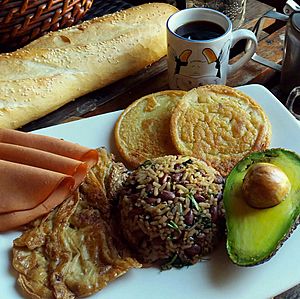
Costa Rican food mixes flavors from Native American, Spanish, African, and other cultures. Dishes like the traditional tamale and many corn-based foods show its native roots. These are similar to foods in other nearby Central American countries. Spaniards brought new ingredients, especially spices and farm animals. Later, in the 1800s, African flavors added to the mix. This is why Costa Rican food today is so varied. Every new group of people who came to the country influenced its cuisine.
Sports in Costa Rica

Costa Rica first competed in the Summer Olympics in 1936. The sisters Silvia and Claudia Poll have won all four of the country's Olympic Medals in swimming. They won one Gold, one Silver, and two Bronze medals.
Football (soccer) is the most popular sport in Costa Rica. The national team has played in five FIFA World Cup tournaments. They reached the quarter-finals for the first time in 2014. Their best result in the regional CONCACAF Gold Cup was second place in 2002. Paulo Wanchope, a forward who played in England's Premier League, helped make Costa Rican football known around the world. Costa Rica will host the 2022 FIFA U-20 Women's World Cup.
As of late 2021, Costa Rica's women's national volleyball team is the top team in Central America's AFECAVOL zone. Costa Rica also has a women's national team in beach volleyball.
Education in Costa Rica
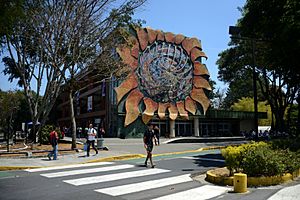
About 97 percent of people in Costa Rica can read and write. English is widely spoken, mainly because of Costa Rica's tourism industry. When the army was abolished in 1949, it was said that the "army would be replaced with an army of teachers."
The constitution guarantees free public education. Primary school is required, and both preschool and high school are free. Students who finish 11th grade get a Costa Rican Bachillerato Diploma. This is approved by the Ministry of Education.
There are both state-funded and private universities. The state-funded University of Costa Rica is the largest university. It has about 25,000 students at many campuses across the country.
A 2016 report from the U.S. government pointed out some challenges for the education system. One challenge is that many high school students drop out. The country also needs more workers who speak English and other languages like Portuguese, Mandarin, and French. It would also benefit from more graduates in science, technology, engineering, and math (STEM) fields. In 2024, Costa Rica was ranked 70th in the Global Innovation Index.
Related Pages
- Costa Rican people
- Costa Rica at the Olympics
- Costa Rica national football team
- List of rivers of Costa Rica
Images for kids
-
A stone sphere created by the Diquis culture at the National Museum of Costa Rica. The sphere is the icon of the country's cultural identity.
-
An Intel microprocessor facility in Costa Rica that was, at one time, responsible for 20% of Costa Rican exports and 5% of the country's GDP.
-
A coffee plantation in the Orosí Valley
-
An industrial park in Heredia
-
Poás Volcano Crater is one of the country's main tourist attractions.
-
Costa Rican breakfast with gallo pinto
See also
 In Spanish: Costa Rica para niños
In Spanish: Costa Rica para niños




